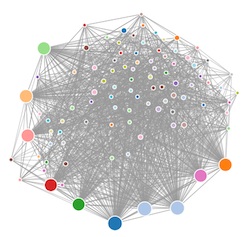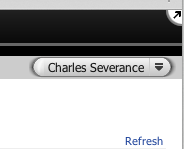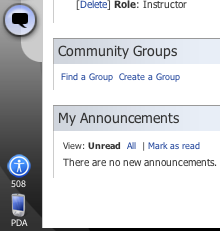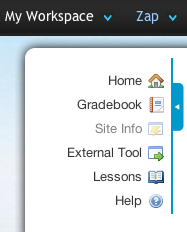This post is a response to Michael Feldstein’s recent excellent post about Martin Dougiamas of Moodle, Josh Coates of Instructure and me “representing” Sakai.
The Blackboard Announcements, Part 2: Can Open Source Be Bought?
Michael’s post is (as always) well written and does a good job of capturing the kinds of possible outcomes that might occur if Martin, Josh, or I were somehow replaced by an exact (but evil) duplicate.
It is not the first time in several weeks that I had a conversation about me becoming evil. While I was talking to Michael Chasen about joining Blackboard, I told him the some people would assume that he had removed my regular brain and replaced it by a remote control robot brain that he controlled.
We both laughed. So far, I can assure you with 100% certainty that my brain has not been replaced by a red glowing evil robot brain (i.e. iRobot). But actually, if I think about it for a moment, if my brain had been replaced by an evil robot brain, it would likely be programmed so that I would think that it had not been replaced. And also that would mean that right now instead of telling the truth like I usually do in my blog posts, my robot evil brain would be programmed to lie convincingly and I would not even know the differnz dsjaji xzsaiew lsajd slj lslkjd……

Stack overflow - core dumped
^@^@^@^@__DATA^@^@^@^@^@^@^@^@^@^@^@^@0^@^@^@^@q^@^@ ^@^@^@^@^
B^@^@^@^@^@^@^@^@^@^@^@^@^@^@^@^@^@^@^@^@__nl_symbol_ptr^@__DATA
^@^@^@^@^@^@^@^@^@^@^@^@0t^@^@^@^P^@^@ t^@^@^@^B^@^@^@^@^@^@^@^@
^@^@^@^F^@^@^@^Q^@^@^@^@__la_symbol_ptr^@__DATA^@^@^@^@^@^@^@^@
^@^@^@^@0<84>^@^@^@D^@^@@^A^@^@/usr/lib/libmx.A.dylib^@^@^@^@^@
^L^@^@^@4^@^@^@^XC½m¥^@X^A^C^@^A^@^@/usr/lib/libSy
Rebooting....
Damn Evil Robot Brains and their memory leaks! Every since these robot brains were upgraded to Lion, they seem to have instability problems. I wonder if I can format my evil robot brain and reinstall Snow Leopard?
Ah well, back to my post.
As I was saying, Michael Feldstein’s post was great but his metaphor of good and evil is just not appropriate. First, when people do things, they have a reason and logic for them. At some point a situation changes, the market changes, and someone changes their mind about something and takes a different but still logical course of action based on the new conditions.
A Billion Dollars…
I prefer to wonder what might happen if each of the people in Michael Feldstein’s post were offered a billion dollars. It is a slightly more likely scenario than someone becoming evil due to a virus in SkyNet. And I will add Michael Chasen – the CEO of Blackboard to the list of soon-to-be billionaires.
Lets assume Apple Computer wanted an LMS and were willing to spend two seconds of their worldwide revenue (a billion dollars) on the purchase and made four people an offer of a billion dollars for their LMS software. Lets assume just for the sake of argument that the billion dollar offer is way more than the software is worth and all four would take the billion dollar offer.
What if Michael Chasen were offered a billion dollars for Blackboard Learn?
- The software is copyright all rights reserved and there are no legitimate copies of the software outside of Blackboard.
- Michael signs a paper transferring his rights to the software (which are complete) to Apple
- Apple can do anything it likes with its new asset (the source code to BBLearn)
- If a Blackboard employee happens to have a copy of the source code on their laptop, there is nothing they can do with that source code without getting sued by Apple.
What if Josh Coates were offered a billion dollars for Instructure?
- The software is copyright Affero GPL
- Josh signs a paper transferring his rights to the software (which are complete) to Apple
- Apple can do anything it likes with its new asset including changing the license to copyright all rights reserved and doing all further development proprietary and closed source
- If someone outside Instructure had a copy of Canvas one minute before the license was changed to all rights reserved, they could check that copy into github and form a company or community around the software and continue its development. That continued development must be done in a completely open source manner – whether the software is run as software as service *or* if the software is redistributed. Apple does not have to publish their work as open source but anyone else working on the code must publish everything open source.
What if Martin Dougiamas were offered a billion dollars his interest in Moodle?
- The software is copyright GPL. Martin holds copyright to much of the lines of code – but there are lots of other contributions from others where their code is also GPL. All of Moodle is GPL and most of Moodle is owned by Martin.
- Martin signs a paper transferring his interest in Moodle to Apple but he cannot transfer the interest of the other contributors without their explicit consent.
- In order to change the license of all of Moodle to all rights reserved, they would either need to track down every single contributor to Moodle (Start here) and give them a each new MacBook Air (or two) to convince them to sign over their rights to Apple. If any of the contributors refused to sign, Apple would have to re-implement the questionable area of code in a clean-room environment (i.e. developers who work without having ever looked at the source code).
- If Apple did not get approval from every single contributor and still decided to remove the GPL license while no one was looking, they would soon get a visit from Richard Stallman or some other representative of the Free Software Foundation. One time I was sitting in Hal Abelson’s office in the MIT Stata Building, listening to Richard Stallman explain GPL to someone over the phone in the next office over. Trust me – rewriting the software in a clean room is the much easier path.
- If someone (like about 50,000 people) had a copy of Moodle one minute before Martin signed the papers, they could check that copy into github and form a company or community around the software and continue its development. They could even continue development in a non-open repository if they would only run software as a service and not redistribute their code. If they wanted to redistribute a binary copy of their modified Moodle, they would have to publish the modifications to the source code. Oh the delightful irony of a license that was invented before “the cloud” was even imagined and back when we actually used compilers during software development.
What if I were offered a billion dollars for my interest in Sakai?
First the software is copyright the Educational Community License 2.0, an Apache 2.0 variant that allows unlimited open-source or closed-source forks of the code with no restrictions on those forks other than not naming the software ‘Sakai’ and acknowledging the Sakai Foundation and other contributors. So they can have a copy of the software for free with no real restricitons on its use, distribution, or future development. Not a single dollar needs to be exchanged and no persmission is needed, let alone a billion dollars. ECL-Licensed software is truly a no-strings attached gift to anyone who finds themselves in posession of the software.
But what if Apple Really wanted to pay me a billion dollars for my interest in Sakai as a contributor. It turns out that I have some interest in a tiny bit of Sakai – the parts I wrote. Lets charitably say that I wrote three percent of the code in Sakai. I maintain an interest in some of that code. Not an exclusive interest – but under the terms of my Contribution License Agreement (CLA), I have a right to keep a copy of my own work in addition to the copy I contribute to the Sakai Foundation. But of my three percent of the overall Sakai code, most likely 2.5 percent was done during the years 2003-2007 when I was a UMich employee focused on Sakai, so actually the contribution of that 2.5 percent of the code came from Michigan not from me. Since 2007 (0.5 percent of the Sakai code) I have been a faculty member instead of a staff member so a case could be made that I have interest in things like the Basic LTI portlet that I wrote after 2007.
But because of my signed Contribution Agreement, I gave the Sakai Foundation an unrestricted, non-revokable copy and the foundation gives that copy away to anyone at no cost so there is little to be gained in buying it from me.
So I have nothing to sell to Apple – except my charm and good looks – even if they offer me a billion dollars. Perhaps they would be interested in purchasing a signed and notarized quit-claim deed for the Brooklyn Bridge from me.
Summary
Apple literally does not have any reason to pay any one or any organization “buy” Sakai. They can have it virtually unrestricted at no cost. Because Martin holds the copyright of Moodle, technically he could sell his interest to Apple – but because he does not own it all, he can only sell the part he owns. In a sense, while Martin owns most of Moodle, all of Moodle is held jointly between Martin and the Moodle community. It is a common practice in GPL-style projects to simply not worry about who owns what. This many-way joint ownership is a nice insurance policy against GPL projects going proprietary.
Michael Chasen and Josh Coates (and their companies) truly own every single line of code in their products. The AGPL license for Canvas insures that an open source community could continue after any sale – but the AGPL really limits significant large-scale commercial adaptation for anyone other than the original copyright holder.
No one is ‘evil’ here. Each company or open source community is protecting its interests and expressing their organization/community values by making very concious choices about the copyright applied to their code.
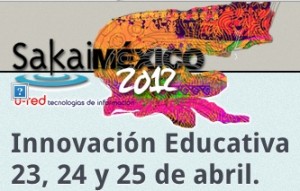 I will be giving a keynote at the first Sakai Mexico Conference Monday April 23 at 12:30 – after lunch.
I will be giving a keynote at the first Sakai Mexico Conference Monday April 23 at 12:30 – after lunch.